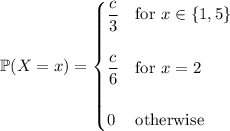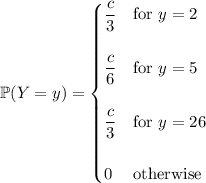
Mathematics, 31.07.2019 11:00 savannah19dw
Consider a discrete random variable x with pmf px (1) = c 3 ; px (2) = c 6 ; px (5) = c 3 and 0 otherwise, where c is a positive constant. 1. find c. 2. compute p(x > 2). 3. compute e[x] and var(x). 4. let y = x2+1, find the pmf of y: 5. compute

Answers: 1
Another question on Mathematics

Mathematics, 20.06.2019 18:04
Order the numbers in each list from least to greatest. 0, |−14|, 13, −12, |−16|, 17
Answers: 2

Mathematics, 21.06.2019 23:50
Which of the following are independent events? a) knowing that it is going to rain tomorrow, and bringing an umbrella to schoolb) knowing that you have to get up early tomorrow, and going to bed before 9 p.mc) knowing that it is going to rain tomorrow, and going to bed before 9 p.md) knowing that you have a test in school tomorrow, and studying thw night before
Answers: 2

Mathematics, 22.06.2019 00:00
One of the complementary angles is 4 degrees mor than the other. find the angles (recall that complementary angles are angles whose sum is 90 degrees.) which of the following can not be used to solve the problem if x represents one of the angles? a. 2x-4=90 b. 2x+4=90 c. x+4=90
Answers: 1

Mathematics, 22.06.2019 00:30
You are riding your bike and notice the square sign above. you mentally draw a straight line from point a to c. describe the angle relationship between dca and bca
Answers: 1
You know the right answer?
Consider a discrete random variable x with pmf px (1) = c 3 ; px (2) = c 6 ; px (5) = c 3 and 0 ot...
Questions



Mathematics, 13.10.2020 14:01


English, 13.10.2020 14:01

Mathematics, 13.10.2020 14:01


Mathematics, 13.10.2020 14:01

Business, 13.10.2020 14:01


Mathematics, 13.10.2020 14:01


Mathematics, 13.10.2020 14:01

Mathematics, 13.10.2020 14:01

Mathematics, 13.10.2020 14:01


Mathematics, 13.10.2020 14:01

Mathematics, 13.10.2020 14:01









 , then
, then  , where we take the positive root because we know
, where we take the positive root because we know  can only take on positive values, namely 1, 2, and 5. Correspondingly, we know that
can only take on positive values, namely 1, 2, and 5. Correspondingly, we know that  can take on the values
can take on the values  ,
,  , and
, and  . At these values of
. At these values of 


